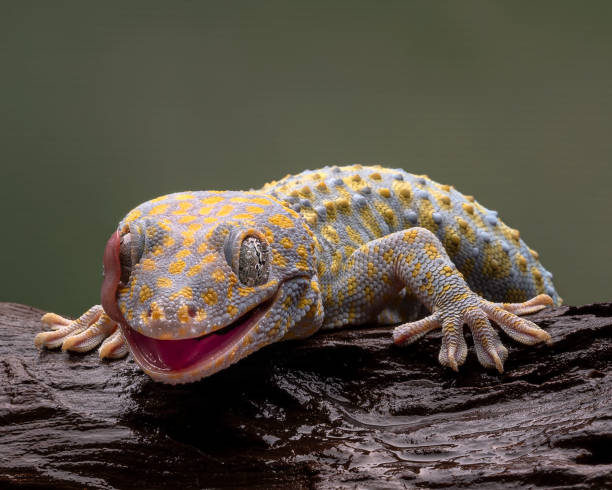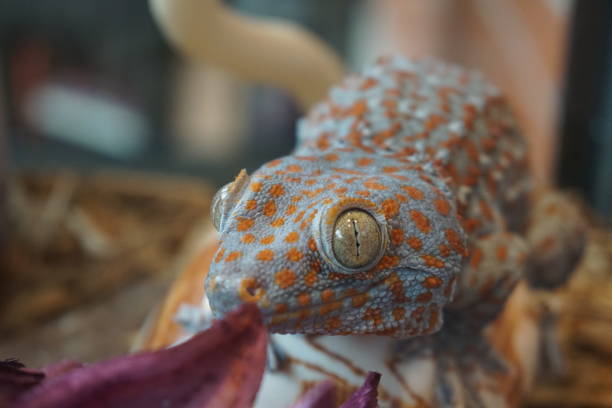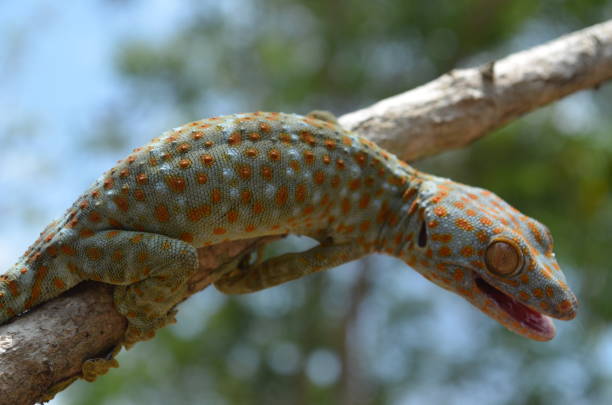
In the world of reptiles, few creatures are as notorious for their aggression as the Tokay Gecko. With their striking appearance and unique vocalizations, these reptiles have gained quite a reputation among pet owners and reptile enthusiasts. However, it is important for those who interact with Tokay Geckos to understand the reasons behind their aggressive behavior and the proper methods of handling them. By delving into the factors that contribute to their aggression and employing effective techniques, you can ensure a harmonious relationship with these captivating creatures.
Physical Characteristics of Tokay Geckos
Size and shape
Tokay Geckos are a large species of gecko, reaching an average length of 10-12 inches. They have a robust and muscular build, with a stocky body and a thick, tapering tail. Their limbs are strong and well-developed, enabling them to navigate their environment with ease. The head of a Tokay Gecko is large and triangular, with prominent eyes and a wide mouth. Overall, their physical appearance is characterized by their strong and sturdy structure.
Coloration and markings
One of the most striking features of Tokay Geckos is their vibrant coloration and distinctive markings. They have a beautiful combination of blue-gray and reddish-brown hues, which are further accentuated by their speckled or banded patterns. These patterns vary between individuals, resulting in a unique appearance for each gecko. Additionally, Tokay Geckos have large, dark spots on their body, creating an eye-catching display. The bright coloration and markings of these geckos serve various purposes, including mate recognition, camouflage, and communication.
Behavioral Traits of Tokay Geckos
Aggression towards humans
Tokay Geckos have gained a reputation for their aggression towards humans. It is important to note that this behavior is often a response to perceived threats or interactions that may cause stress or discomfort for the gecko. When cornered or handled improperly, Tokay Geckos may display aggressive behaviors such as biting and hissing. It is crucial for owners to understand and respect the natural instincts of these geckos to minimize the risk of aggressive encounters.
Territorial behavior
Tokay Geckos are highly territorial creatures. They establish and defend their territory, which can lead to aggressive behavior towards intruders, including other geckos or even humans. This territorial instinct is particularly pronounced in males, who may engage in territorial disputes, vocalizations, and aggressive displays to assert dominance. Understanding and managing territorial behavior is essential to ensure a harmonious environment for Tokay Geckos.
Vocalizations
Tokay Geckos are known for their distinctive vocalizations, which can range from clicks and chirps to loud and deep croaking sounds. These vocalizations serve several purposes, including territorial communication, mate attraction, and threat warnings. It is fascinating to observe these geckos communicate through sound, but it is essential to remember that their vocalizations can also indicate aggression or stress. Proper interpretation of these vocalizations is crucial when interacting with Tokay Geckos.
Nocturnal habits
Tokay Geckos are primarily nocturnal creatures, which means they are most active during the nighttime. This behavior is an adaptation to their natural habitat and allows them to avoid predators and potential threats. When kept as pets, it is important to provide them with an appropriate environment that simulates their natural nocturnal behavior. This includes providing low-light conditions and allowing them to rest during the day.

Reasons for Aggressiveness in Tokay Geckos
Evolutionary adaptations
Aggressiveness in Tokay Geckos has evolutionary roots. In the wild, their aggressive behaviors aid in securing territory, protecting resources, and ensuring survival. By exhibiting aggression, Tokay Geckos can establish dominance and ward off potential threats, including predators or rival geckos. These instincts have been ingrained in their behavior over generations, making them more likely to display aggression in certain situations.
Protecting territory and resources
Tokay Geckos are known to fiercely guard their territory and resources. This defensive behavior is crucial for their survival. In the wild, suitable habitats may be scarce, and competition for food, shelter, and mates is intense. As a result, Tokay Geckos are inclined to exhibit aggression to safeguard their territory and ensure they have access to the necessary resources. Understanding the importance of territory for these geckos is essential for responsible ownership.
Fear and defense mechanisms
Tokay Geckos may also display aggressive behavior as a response to fear or perceived threats. When faced with a stressful or unfamiliar situation, they may resort to defensive mechanisms, such as biting, hissing, or puffing up their body, to protect themselves. It is crucial for owners to create a secure and comfortable environment for their geckos to minimize stress and reduce the likelihood of aggressive encounters.
Handling Aggressive Tokay Geckos
Safety precautions
Handling aggressive Tokay Geckos requires careful consideration and safety precautions. It is important to wear gloves or use a gentle restraining tool, such as a soft cloth or reptile hook, to prevent bites or scratches. Approach the gecko slowly and avoid sudden movements that may startle or provoke it further. It is also advisable to handle them in a confined and secure space, such as a specially prepared handling container.
Creating a stress-free environment
To mitigate aggression in Tokay Geckos, it is essential to create a stress-free environment. This includes providing appropriate hiding spots, such as branches, rocks, or artificial caves, where the gecko can retreat and feel secure. Maintaining consistent temperature and humidity levels within their enclosure is also crucial to ensure their well-being. Minimizing loud noises, disturbances, and frequent handling can help reduce stress and aggressive behavior.
Building trust through positive interactions
Building trust with an aggressive Tokay Gecko requires patience and positive interactions. Start by offering them food using tweezers or tongs, gradually getting closer to their body. Over time, they may associate your presence with positive experiences, such as food or gentle interactions, and become more comfortable with your presence. Avoid forcing interactions or handling them excessively, as this may exacerbate their aggression.

Providing the Right Environment for Tokay Geckos
Proper enclosure setup
Providing the right enclosure setup is crucial for the well-being of Tokay Geckos. A terrarium with a minimum size of 30 gallons is recommended, as they require ample space to move and climb. Use substrates such as coconut fiber or reptile carpet, which are safe for reptiles and facilitate easy cleaning. Include branches, vines, and other climbing structures to encourage natural behavior. The enclosure should also be escape-proof and well-ventilated.
Temperature and humidity requirements
Maintaining appropriate temperature and humidity levels is vital for the health of Tokay Geckos. The terrarium should have a thermal gradient, allowing them to thermoregulate by moving between warm and cool areas. The temperature in the warm end should be around 80-85°F, while the cool end should range from 75-80°F. Humidity levels should be kept between 60-80%, mimicking the tropical environments these geckos inhabit.
Hiding spots and climbing opportunities
Providing hiding spots and climbing opportunities is essential to cater to the natural behavior of Tokay Geckos. The enclosure should include plenty of hiding spots, such as artificial caves or hollow logs, where the geckos can retreat and feel secure. These hiding spots also serve as thermoregulation spots. Adding branches, vines, and other climbing structures allows the geckos to exercise and explore their environment, promoting their physical and mental well-being.
Feeding and Nutrition for Tokay Geckos
Understanding dietary needs
Tokay Geckos are opportunistic insectivores, meaning their diet primarily consists of insects. They require a varied diet that includes appropriately sized prey, such as crickets, roaches, mealworms, and silkworms. Calcium-rich insects should be dusted with calcium and vitamin D3 supplements to prevent nutritional deficiencies. Additionally, providing gut-loaded prey, which have been fed a nutritious diet, ensures that the geckos receive optimal nutrition.
Offering a varied diet
To ensure a well-rounded diet, it is important to offer a variety of prey items to Tokay Geckos. This helps provide a diverse range of nutrients and prevents dietary monotony. Consider incorporating other insect species, such as waxworms, earthworms, and grasshoppers, into their diet. It is crucial to research the nutritional needs of the geckos and consult a veterinarian or herpetologist for guidance on maintaining a healthy and balanced diet.
Supplements and calcium requirements
Tokay Geckos require adequate calcium supplementation to maintain strong bones and prevent metabolic bone disease. Dusting prey items with a reptile-specific calcium supplement is recommended, especially for growing geckos and gravid females. The supplementation should also include vitamin D3, which aids in calcium absorption. However, it is essential to strike a balance and not over-supplement, as excessive vitamin D3 can be harmful to their health.

Maintaining Hygiene and Health
Cleaning the enclosure
Regular cleaning of the enclosure is crucial to maintain hygiene and prevent the buildup of bacteria or parasites. Remove any uneaten food, feces, or shed skin promptly. Spot clean the enclosure as needed, and conduct a thorough cleaning at least once a month. Use a reptile-safe disinfectant to clean surfaces and rinse thoroughly. Cleaning and disinfecting any equipment, such as water dishes and hides, is equally important to prevent the spread of pathogens.
Routine health checks
Monitoring the health of Tokay Geckos through routine checks is essential for early detection of potential issues. Regularly observe their behavior, appetite, and body condition. Check for any signs of illness, such as lethargy, weight loss, abnormal feces, or skin lesions. Keep a record of their feeding habits and shedding patterns. Schedule regular visits to a reptile veterinarian for comprehensive health assessments, including fecal examinations and blood tests.
Common health issues and their treatments
Tokay Geckos may be susceptible to several health issues, including metabolic bone disease, respiratory infections, and parasites. Metabolic bone disease results from calcium and vitamin D3 deficiencies and requires veterinary intervention. Respiratory infections may be caused by improper temperatures or poor husbandry practices. Parasitic infestations, such as mites or worms, can be treated with appropriate medications prescribed by a reptile veterinarian.
Seeking Professional Help
When to consult a reptile veterinarian
Consulting a reptile veterinarian is crucial for the health and well-being of Tokay Geckos. It is recommended to seek professional help when encountering any signs of illness, behavioral abnormalities, or reproductive issues. Additionally, a reptile veterinarian can guide you in proper husbandry practices, provide nutritional advice, and ensure your gecko receives necessary vaccinations and preventative treatments.
Finding an experienced herpetologist
When seeking professional help for Tokay Geckos, it is vital to find an experienced herpetologist or reptile veterinarian who specializes in reptile care. Their knowledge and expertise will be invaluable in ensuring the best possible care for your geckos. Consider researching local reptile specialists, seeking recommendations from other reptile owners, or reaching out to reputable reptile organizations for guidance.
Interacting with Tokay Geckos
Observing behavior cues
Observing behavior cues is essential when interacting with Tokay Geckos. Pay attention to their body language, vocalizations, and reactions to determine their comfort level and mood. Signs of aggression may include hissing, lunging, tail waving, or biting. Conversely, relaxed and content geckos may exhibit gentle swaying or basking behaviors. Understanding these cues allows you to tailor your interactions to their needs and ensure a positive experience.
Handling techniques for aggressive geckos
Handling aggressive Tokay Geckos requires a cautious approach. If necessary, use gloves or a gentle restraining tool to avoid bites or scratches. Consider using a soft cloth or reptile hook to direct their movements gently. Gradual desensitization may also be beneficial, starting with short handling sessions and gradually increasing the duration as the gecko becomes more comfortable. However, it is crucial to respect their boundaries and never force interactions.
Socializing with non-aggressive geckos
Socializing with non-aggressive Tokay Geckos can be a rewarding experience. Once trust is established, you can engage in gentle interactions, such as allowing them to crawl onto your hand or arm. Observe their body language and respond accordingly. Offer treats or their favorite food as positive reinforcement. However, it is important to ensure that the gecko’s well-being is prioritized, and interactions are limited to prevent stress or overstimulation.
Responsible Ownership of Tokay Geckos
Legal considerations
Before acquiring a Tokay Gecko, it is essential to familiarize yourself with the legal considerations surrounding their ownership. Check local and national laws and regulations regarding the possession, importation, and sale of these geckos. Ensure you obtain your geckos from reputable sources that comply with legal guidelines. Responsible ownership entails abiding by relevant laws and preventing the illegal trade or release of Tokay Geckos into the wild.
Providing a spacious and stimulating environment
Responsible ownership of Tokay Geckos involves providing them with a spacious and stimulating environment. Invest in an appropriately sized enclosure that allows them to exhibit natural behaviors, such as climbing and exploring. Regularly assess and enrich their habitat by adding new hiding spots, changing climbing structures, or introducing safe and interactive toys. A stimulating environment promotes their physical and mental well-being.
Continuous learning and growth as a reptile owner
As a responsible owner of Tokay Geckos, it is crucial to engage in continuous learning and growth. Stay informed about the latest research, husbandry practices, and advancements in reptile care. Join reptile forums or communities to connect with fellow gecko enthusiasts. Attend reptile expos, seminars, or workshops to expand your knowledge and gain insights from experienced herpetologists. Never stop seeking ways to improve the care and well-being of your geckos.